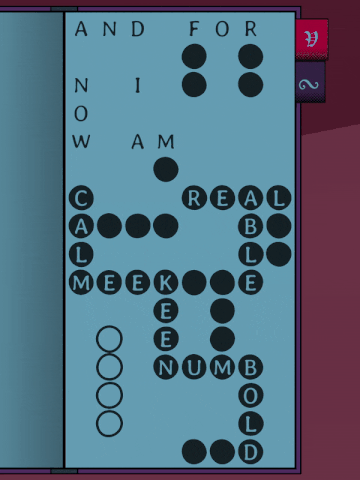In a recent newsletter, we wrote about the role of the body in cognition. About how the physical world is a part of our cognitive processes and how we constantly interact with it in order to think and understand. This time we will apply this theory to game design. Today’s pressure cooker dish will be a stew of delicious game feel juice and crunchy feedback, seasoned with tasty friction oils.
Games, as an art form1 as well as as entertainment, speak to our emotions on several layers. Their narrative arc has emotional heft. They feature evocative music and visuals. They are full to the brim of feeling-inducing drama. To top it off, they often simulate a lot being at stake and tell us that it’s absolutely our fault if the world goes to pieces, virtual friends die, or the ghosts catch up with the pizza-bodied entity because it failed to consume enough pills. These grand feeling-inducing arcs are not what we will concern ourselves with today. Much has been written about them and very often theories from related areas – drama, theatre, narratology, ludology, movies – can readily be applied. What we will focus on instead is the microscopic level of interacting with games. Controls, camera, and character. The combination that is unique to video games, making them core to the gameplay experience (in relation to the player).
Broadly speaking, there are three kinds of game feel in moment-to-moment gameplay: physicality, amplification, and support. Let’s go through them one by one on hand of VITRIOL.
Physicality means the partial simulation of a physical world, which is found in nearly2 all games. We administer it by giving virtual objects weight, heft, and inertia. This allows for us humans to apply the rules of the physical world to the game world. In VITRIOL, we added a lot of haptic feedback. Nearly every time you put down your finger, you get confirmation via vibration. We tried to be very subtle, so most players will not consciously register this feedback layer. But it is there and we hope you feel it.
Physical simulation additionally makes game objects predictable. It stores the state of an object for a time span. What does that mean? It means that when we let go of a button and the character takes a few more steps because of momentum, during that time the history of movement is still playing out3. We do not have to remember what happened a second ago, because we can just watch the past unfold. This is where the notion of support comes in. Storing information about the past in the present reduces our mental load. In a similar way, a particle effect not only signifies that something important has happened, but also marks the spot where the event happened, for a certain duration. In reality, a gun shot is a near instantaneous event. In many games, bullets mark their path through the simulated world with a trail showing the trajectory. In VITRIOL, when a letter changes position, we draw a trail of ink from the original position to the new position in order to visualise its path, origin, and destination. Here, too, the player does not have to memorise the original position because it is marked for as long as it is relevant.
Another area where we support the player is by carefully manipulating their input. Following Maddy Thorson’s advice of “working on the player’s intent rather than making a precise simulation” (see video above) we, for example, select the closest selectable character on screen if the player taps into an adjacent empty field. If a game designer has a clear understanding of what the player intends to achieve, they might as well support the player instead of running a precise simulation or defaulting to a strict and rigid system.
Finally, amplification is what game feel is best known for. You got to juice it or lose it, as Martin and Petri make clear in the video above. A rather contemplative game like VITRIOL needs to hold back a little bit with juice, of course. We even made it one of our design pillars4 to have no magical special effects in our game. We purely use ink – from streaks to blotches to Rohrschach drawings – and sound for feedback. Yet ink is technically squid juice, so naturally it can be used to highlight success, signify failure, and mark trajectories:
A different, phenomenological perspective on this topic is to regard all of these little game feel pieces as frictions5. They are micro-feedback elements that work against the player. They offer guidance by resistance, drama by timing, crunch by build-up and release. They structure interactivity and reward.
There is so much more to say about this topic that I recently wrote a whole academic article about it. It describes 31 ways of inducing game feel and 216 references to continue reading about it. Use it as a cheat sheet for how and where to dig deeper (to find dinosaur juice6). I am not claiming that there is a science for making games feel right but there is certainly an analytical angle, as well as a reflected stance, that can help designers to make conscious decisions.
If you now want to touch something, and I would understand that, I can recommend getting one of our official VITRIOL tote bags. They come with actual physicality – as in, they are physical objects on this plane of existence. And they can now be ordered directly from our friends at Credo Quia Absurdum who also did the amazing chapter title art of our game.
My opinion on the ‘are games art?’ discourse is: yes, games are art, but not the kind of art you think they should be.
One could argue that pure text adventures have no physics simulation, but you can “drop” items. Maybe pure mathematical puzzles are a true exception for this but even those tend to have a spatial layout. It’s all a matter of perspective and maybe just bear with me.
An extreme case of movement persistence is the “coyote jump”, a standard ingredient of road runner cartoons and platformer games.
This would be a great topic to write about in one of the next newsletters.
I am giving you the assignment to read Tim Rogers’ In Praise of Sticky Friction after this newsletter. You may open it in a browser tab now, maybe let it settle a little bit until you are ready but then you should take a deep breath and dive through that maelstrom of befuddling enlightenment.
I am aware that oil is plankton and algae juice.





